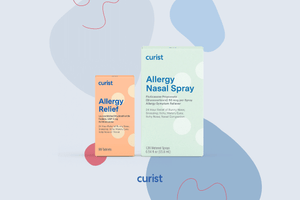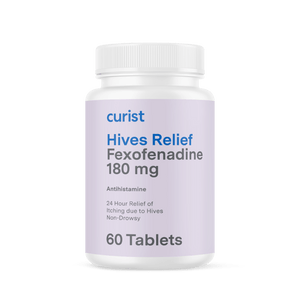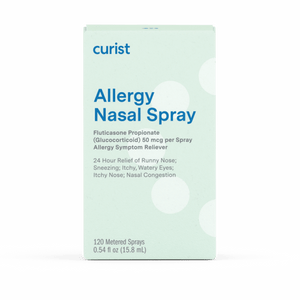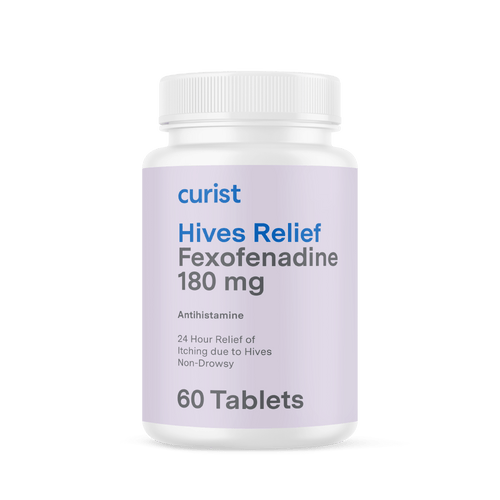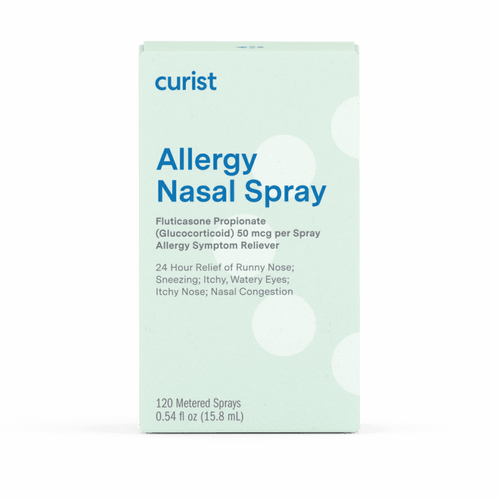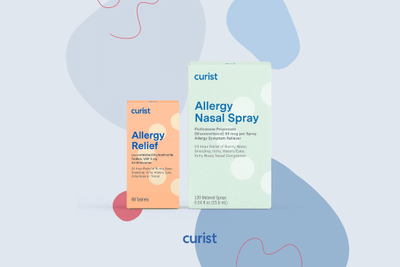By Sophie Kang, Rutgers University, Ernest Mario School of Pharmacy
Curist delivers over-the-counter medicines to your door at a fraction of the price of traditional brands. We hope everyone stays safe and healthy during this time.
Are you having trouble figuring out the differences among the various allergy medications? You definitely have a plethora of options, but today, we are going to be taking a closer look at Allegra (fexofenadine) and Flonase (fluticasone). We will compare Allegra versus Flonase and discuss which one might be better fit for treating your allergy symptoms!
What is Flonase? What is Allegra?
Flonase (fluticasone) is an intranasal steroid spray, specifically designed to offer relief from nose and eye-related allergy symptoms. Flonase also has anti-inflammatory properties which can help decrease swelling in your nose.
Allegra (fexofenadine) is a long-lasting, fast-acting oral antihistamine that works by blocking the effects of histamines in our body. Allegra can help with allergy symptoms such as itchy eyes, watery eyes, runny nose, sneezing, itchy throat, skin rashes, and/or hives.
Both Flonase (fluticasone) and Allegra (fexofenadine) are also available over-the-counter (OTC) without a doctor’s prescription. Generic versions are available at Curist with the same strength medicine at a fraction of the brand prices, see Curist Allergy Relief (fexofenadine) and Curist Allergy Nasal Spray (fluticasone).
Is Flonase the Same as Allegra?
Flonase is not the same thing as Allegra. Even though Flonase (fluticasone) and Allegra (fexofenadine) both help reduce allergy symptoms, Flonase and Allergra work differently in terms of their mechanisms of action. Flonase is only available as a nasal spray, and it works by reducing the severity of inflammation in your nose caused by allergies. Allegra, on the other hand, is an oral antihistamine that works by blocking the effects of histamine, a chemical made by the body that contributes to allergy symptoms. Allegra can help treat allergy symptoms such as itchy eyes, watery eyes, runny nose, sneezing, itchy throat, and itchy nose. Flonase can treat some of the same allergy symptoms as Allegra, but can also treat nasal inflammation and nasal congestion.
Generic versions are available at Curist with the same strength medicine at a fraction of the brand prices, see Curist Allergy Relief (fexofenadine) and Curist Allergy Nasal Spray (fluticasone).
Do Flonase and Allegra Do the Same Thing?
Both Flonase (fluticasone) and Allegra (fexofenadine) can help reduce your allergy symptoms, but they contain different active ingredients and work slightly differently. Flonase (fluticasone) is a corticosteroid that works by blocking the effects of six different inflammatory chemicals in your body, which include histamine, prostaglandins, leukotrienes, cytokines, tryptases, and chemokines, all of which are responsible for causing your common allergic symptoms. Flonase (fluticasone), which is available as a nasal spray, works right in your nose to block the allergic reactions and reduce nasal swelling. Flonase Sensimist is another nasal spray delivered through a mist that can also treat watery eyes. Unlike Flonase, Allegra (fexofenadine) is an oral antihistamine that blocks the effect of histamines only. As Allegra (fexofenadine) is taken by mouth, it can travel throughout your body to help block the effects of histamine, thus reducing allergy symptoms in multiple areas of the body, including your eyes, nose, and throat.
What Do Flonase and Allegra Treat?
Flonase (fluticasone) is used to treat seasonal and year-round allergy nasal symptoms, such as sneezing, itchy, stuffiness, and runny nose in adults and children. Flonase can also help relieve watery eyes depending on the formulation - Flonase Sensimist is delivered via a nasal mist spray and can treat watery eyes as well. Flonase (fluticasone) can sometimes be used for nonallergic nasal symptoms, where the cause of nasal symptoms is unknown and may be due to a multitude of environmental, medication, or hormonal triggers.
Similar to Flonase (fluticasone), Allegra (fexofenadine) can treat allergy symptoms such as itchy eyes, watery eyes, runny nose, sneezing, itchy throat, skin rashes, and/or hives. Allegra can also treat hives, which is an allergic reaction characterized by raised welts on the skin. Allegra both reduces hives and relieves itching due to hives.
What is the Difference Between Allegra and Flonase?
The main differences between Allegra (fexofenadine) and Flonase (fluticasone) are the dosage form and mechanisms of action.
Flonase (fluticasone) is available as a nasal spray and blocks allergic reactions right in your nose. Flonase can also be used for non-allergy symptoms, which are symptoms resembling nasal allergic reactions but have no known cause. Since Flonase (fluticasone) is only to be used through spraying in your nose, it may cause a burn if used inappropriately (e.g., in your eyes or mouth). Flonase should be shaken well before use, and overall, it is a well-tolerated medication. Many people have no side effects or only mild side effects, such as headache, nausea, vomiting, or cough. You might also experience a slightly unpleasant smell or taste or drying of your nose. If any of these side effects bother you or do not resolve over time, make sure to consult your healthcare provider or a local pharmacist.
Allegra (fexofenadine) is available as a tablet and a liquid form for children. Similarly to Flonase, Allegra (fexofenadine) is very well-tolerated. The most common side effect seen is headaches, but some may also experience fatigue, drowsiness, and diarrhea. Vomiting has also been seen with use of Allegra (fexofenadine) among children 6 months to 5 years of age. If any of these side effects bother you or persist or if you are unsure whether these side effects are because of your allergy medications, make sure to consult your healthcare provider or a local pharmacist.
Which is More Drowsy or Sedating, Flonase or Allegra?
Comparatively, Allegra (fexofenadine) can cause more drowsiness or sedation than Flonase (fluticasone), though both Allegra and Flonase are considered to be non-sedating. Flonase does not cause drowsiness because of its specific mechanism of action. it acts directly and locally in your nose area. Allegra (fexofenadine), on the other hand, is a second-generation oral antihistamine. Even though drowsiness has been reported among a small number of patients on Allegra, overall, it is still considered to be non-sedating. Additionally, drowsiness or sedating effects of Allegra (fexofenadine) are generally minimal when compared to older first-generation antihistamines such as diphenhydramine (Benadryl).
Which Works Best for Allergies, Allegra or Flonase?
Studies have found that regular use of a steroid nasal spray such as Flonase (fluticasone) may be more effective for treating allergies than using an oral antihistamine such as Allegra (fexofenadine) for preventing and treating allergy symptoms. Depending on the location and severity of your allergy symptoms, it is recommended to trial a steroid nasal spray like Flonase (fluticasone) first before adding on an oral antihistamine such as Allegra (fexofenadine). With that being said, we understand everyone reacts differently to different medications, so if you try Flonase and it is not working well for you, consider adding on Allegra next for additional symptom relief. If you are unsure which medication works best for you, consult your doctor or speak to a local pharmacist for help and guidance.
Which Allergy Medicine is Better for Treating Sinusitis: Flonase or Allegra?
Sinusitis is inflammation of tissues lining your sinuses, which are passages near the nose. Symptoms of sinusitis may include a runny or stuffy nose, headaches, facial pain or pressure, sore throats, and a cough. Flonase (fluticasone) is typically recommended for sinusitis as it works directly in your nose to reduce swelling and is better at treating sinusitis than Allegra (fexofenadine). While Allegra (fexofenadine) can help relieve itchy eyes, watery eyes, runny nose, sneezing, itchy throat, it cannot relieve inflammation. Thus, for sinusitis, using Flonase (fluticasone) may be a better choice for providing symptom relief compared to Allegra (fexofenadine).
Which Allergy Medicine is Better for Treating Hives: Flonase or Allegra?
Hives are an allergic reaction characterized by itchy, red, raised spots on your skin, and it can appear anywhere on your body. Allegra (fexofenadine) is typically recommended in this setting as the medication travels throughout your body, targeting areas with hives and reducing allergic symptoms. Because Flonase (fluticasone) is only available as a nasal spray, it may not work as well in relieving symptoms anywhere else in your body besides the nose.
Can I Take Flonase and Allegra Together? Can I Take Allegra and Flonase On the Same Day?
Yes, Flonase (fluticasone) and Allegra (fexofenadine) can be taken together, and on the same day. Taking Allegra and Flonase together is considered to be safe, as they work through different mechanisms of action in our body, and for some people can provide greater allergy relief.
Less expensive, generic versions of Flonase and Allegra are available at Curist with the same strength medicine at a fraction of the brand prices, see Curist Allergy Relief (fexofenadine) and Curist Allergy Nasal Spray (fluticasone).


